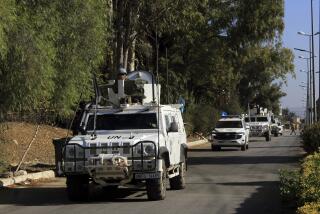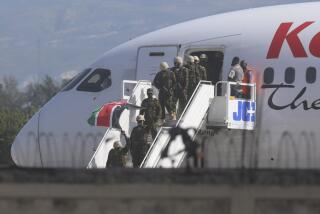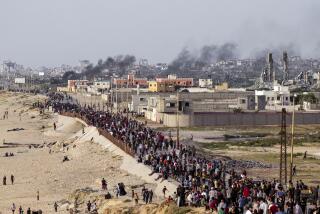Path to Peace in Somalia Fraught With Uncertainty : Africa: Still unclear is what the makeup of the U.N. force will be after the U.S. leaves and who will lead it.
- Share via
MOGADISHU, Somalia — A trip to Somalia is like a visit to a military world’s fair, with each exhibition adding a curious, if heavily armed, zest to the otherwise bleak landscape.
Up on the hill at the airport are the French, with their Foreign Legionnaires sporting giant tattoos on Gargantuan biceps. Turks camp below, preparing chicken on sticks. Dapper Australians strut about under broad-brimmed bush hats. Botswanans with their unfamiliar black, blue and white flag roar around town on jeeps with machine guns at the ready. Brawny Belgians back up American troops in the south and make fun of the flabby paunches on some U.S. soldiers.
In all, 20 countries in addition to the United States have sent troops, ranging in number from three (Zimbabwe) to more than 2,500 (from both Italy and France). As part of the Joint Task Force, the non-American international contingent of 10,210 plays a largely supporting role to the 21,000 U.S. troops here.
Some are stationed in outlying areas, some are confined to the airport. Some, like those from Saudi Arabia, have only begun to venture out for duty as escorts for food deliveries to famished Somalis.
Later, however, international troops are expected to take center stage under the U.N. flag as the Americans pull out. Perhaps another 20 countries will take part. Their performance will spell success or failure for efforts to pull Somalia out of chaos.
Just how the U.N. force will operate is a matter of much conjecture and concern among both U.S. and international commanders. The degree to which Somalia should be pacified before the United States turns over control to the United Nations is also at issue. U.N. peacekeepers generally perform best in stable situations where warring sides are agreeable, and some of the likely peacekeepers hope that the Somalis will cooperate.
“The world cannot help if the Somalis don’t want it. The United Nations’ job is to help, not enforce,” said Col. Hussein Erim, liaison officer in a 300-man Turkish force.
American officials in Mogadishu have expressed impatience with the slowness of the United Nations in appointing a commander to eventually take over from U.S. Marine Lt. Gen. Robert B. Johnston. It is not yet clear who will join the peacekeeping mission: Countries now involved have not necessarily signed on for the long term.
“It’s normal to perform a humanitarian act, but it’s more difficult to go further,” said Col. Omar Essakali, head of a 1,000-man medical unit from Morocco.
The situation varies from place to place, backwater to backwater. In Mogadishu, gunfire still punctuates nightfall, although U.S. officials describe the shooting as the work of free-lance bandits. On Saturday night, shots were fired at a Marine outpost at a major roundabout, and Marines fired back with machine-gun bursts. No one on the Marine side was injured; it is not clear what happened to the snipers.
In inland Baidoa, U.S. officials describe rapid progress toward conciliation of warring clans and militias, as well as the re-creation of a local police force. In the southern port of Kismayu, nighttime shootings and kidnapings from homes are still reported. The part of Somalia where U.S. forces operate has been divided into eight sectors.
American officials devised a rating system for each region to measure the degree of safety and return to normal life. Among the indicators are the number of weapons visible on the streets, the number of armed clashes among militias, the number of clashes between Somalis and foreign forces. Each week, U.S. and international commanders meet to assess each region. A month after U.S. Marines landed in Somalia, none is yet ready for U.N. peacekeepers.
“It took years for Somalia to degenerate to its present state,” remarked Marine Col. Fred Peck, spokesman for the joint military forces. “Give us a few months. This country is a mess.”
American and international troops have stepped up confiscations of weapons from Somalis, but the program seems unsystematic. On Friday, Marines raided a compound of artillery pieces owned by a clan militia and seized the weapons. It turned out that all the artillery was useless because it had been cannibalized for spare parts. In any event, Peck said that clan militias “on good behavior” can keep artillery and other such weapons as long as they are out of sight.
The eventual American pullout may cause other disruptions if sound preparations are not made, international officials caution. Few countries other than the United States could mount the array of transportation necessary for the operation under a single command.
Somalis and relief officials also question whether an amalgam of armies can command the respect that the dominant U.S. contingent can. Somalis appear to hold the attitude that their problem can be solved only with the intervention of the world’s sole military superpower. “It’s a psychological question as much as anything,” said John Marks, a U.N. official.
U.N. peacekeepers in unpacified places often end up as passive bystanders. Even some of the fiercest-looking troops seem to become docile under their powder-blue U.N. berets. “We look like ice cream salesmen, it’s true, but we are peacekeepers and not meant to frighten,” Marks said.
More to Read
Sign up for Essential California
The most important California stories and recommendations in your inbox every morning.
You may occasionally receive promotional content from the Los Angeles Times.










